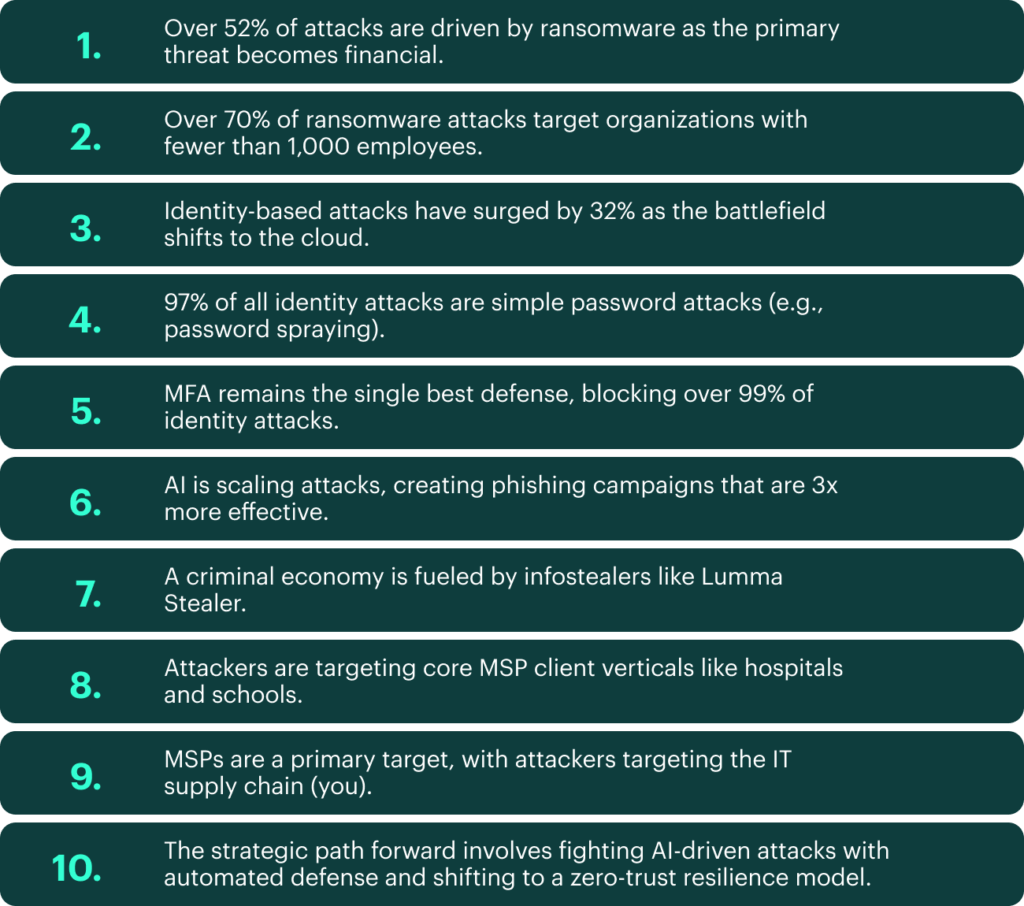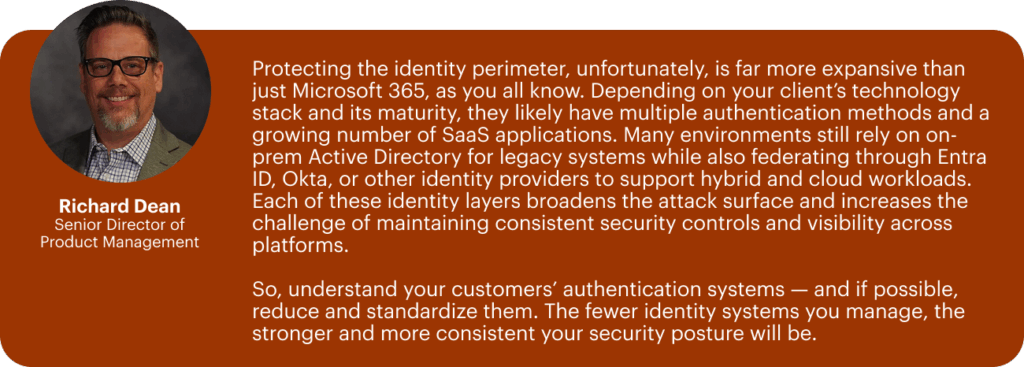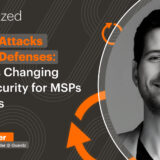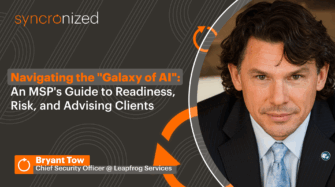Table of contents
Microsoft has recently released its 2025 Digital Defense Report, an 85-page deep dive into the global threat landscape based on over 100 trillion daily security signals.
For Managed Service Providers (MSPs), this report is one of the most critical pieces of strategic intelligence released annually. It provides data-backed proof of the trends you’re already seeing and is an essential tool for educating clients, refining your security stack, and focusing your strategy.
We’ve read the report and have tried to synthesize the most important, MSP-specific takeaways and action items. Here’s what you need to know.
Executive Summary: The 10 Key Takeaways
Microsoft’s 2025 Digital Defense Report confirms the threat landscape is now a for-profit industry. We’ve distilled the 85-page report into the ten most critical data points for MSPs, outlining who is attacking, how they’re doing it, and what you need to do about it.

The full article below unpacks each of these points, providing the context and an actionable playbook for your MSP.
Theme 1: The New Threat Landscape (The “Why” and “Who”)
1. The Motive: It’s an Industry, Not Espionage
Understanding the motivation behind cyberattacks is crucial because it informs your entire security strategy and how you talk to clients. Are you defending against hypothetical nation-state spies or a tangible, for-profit business? The 2025 MDDR indicates it’s the latter.
The Data: Microsoft found that over 52% of all cyberattacks with known motivations are driven by extortion and ransomware. In contrast, espionage accounts for just 4% of attacks.
- Why This Matters: For some, this may be an important shift in mindset. We’re not fighting lone hackers in hoodies or script kiddies in basements. We’re fighting organized, financially-motivated criminal enterprises with R&D budgets, B2B supply chains, and profitability goals. They don’t attack for the challenge; they attack for the payday.
- Your Key Takeaway: This data is your single best tool for overcoming the “it won’t happen to us” client objection. Stop selling “cybersecurity.” Start selling business continuity and financial risk mitigation. Frame your security stack as an insurance policy against the most common and costly business disruptions they face.
2. The Target: Your Clients Are the New Front Line
The “we’re too small to be a target” objection has been the bane of MSPs for years. Attackers, however, follow the path of least resistance. While large enterprises have 24/7 Security Operations Centers (SOCs) and massive budgets, small businesses often represent a softer, more profitable target. The 2025 MDDR data proves this isn’t a theory; it’s the core strategy of financially-motivated attackers.
The Data: The report reveals that over 70% of all human-operated ransomware attacks (the primary, financially-motivated threat from Point #1) targeted organizations with fewer than 1,000 employees.
- Why This Matters: This data proves that SMBs are not “too small to matter”; they are the preferred target. They’re the lowest-hanging fruit for the ransomware-as-a-service industry. Their data is less protected, and they are more likely to pay to avoid a business-ending outage.
- Your Key Takeaway: This is your new silver bullet for the “we’re too small” objection. Your client isn’t being targeted by a spy; they’re being targeted by a business that knows they’re a high-return, low-risk investment. Your job is to flip that equation and make them a high-cost, low-return target.

Theme 2: The Modern Battlefield (The “Where” & “How”)
With the “why” and “who” established, this theme explores the new attack vectors. The battle has moved away from traditional firewalls and onto the cloud, focusing on user identities, AI-driven automation, and a sophisticated criminal supply chain.
3. The Battlefield: Identity is the Only Perimeter That Matters
I don’t think it comes as a big surprise to most that identity is the ripest target. For years, we’ve protected the “perimeter” with firewalls. But with cloud adoption, remote work, and Microsoft 365, the perimeter is gone. The new perimeter is the user’s identity, and attackers know it. They aren’t “hacking” in, but “logging” in.
The Data: Identity-based attacks surged by 32% in the first half of 2025. The most shocking part? More than 97% of all identity attacks are simple password attacks (like password spraying and credential stuffing).
- Why This Matters: For your clients, the password to their Microsoft 365 account is the front door. With data centralized in Microsoft 365 (SharePoint, Teams, OneDrive), compromising one identity is all it takes to exfiltrate a company’s most sensitive data.
- Your Key Takeaway: Your Microsoft 365 management service is now your #1 security service. This is the time to conduct a mandatory M365 security audit for every client. Are they using legacy authentication? Do they have risky sign-ins or impossible travel alerts? This is no longer an “add-on”; it’s a fundamental part of managing their IT.

4. The Silver Bullet: Phishing-Resistant MFA is An Extremely Effective Tool
If identity is the problem, MFA is a solution. The data from Microsoft provides the “why” for making MFA a non-negotiable part of your offering.
The Data: Here is the single most hopeful statistic in the entire report: using multi-factor authentication (MFA)—especially phishing-resistant MFA—can block over 99% of identity-based attacks.
- Why This Matters: We also know that MFA has a friction problem. “MFA fatigue,” lost authenticator apps, and constant reset requests are a huge productivity drain for your help desk. Attackers know this and are actively using MFA fatigue to annoy users into approving a breach.
- Your Key Takeaway: Make phishing-resistant MFA a non-negotiable, mandatory part of your core service agreement. Then, build a profitable service around managing it efficiently.
5. The Accelerator: AI is the Attacker’s New R&D Department
AI isn’t just a buzzword for defenders; it’s a massive force multiplier for attackers. It allows them to scale their operations, improve their tactics, and automate their attacks at a speed no human-only defense can match.
The Data: Attackers are using AI to scale and automate their efforts, from creating “autonomous malware” to building AI-driven phishing campaigns that are three times more effective (or achieve 50x profitability improvements) than traditional ones.
- Why This Matters: You are now fighting attackers who operate at machine speed. The days of easily spotting a “poorly-worded” phishing email are over. AI can now craft perfect, context-aware, personalized emails at the scale of millions.
- Your Key Takeaway: Your defense must also be at machine speed. Automated detection and response is no longer a “nice to have.” It’s the only way to compete. Look to AI and automation tools that can identify, ticket, and remediate threats before a human tech can even log in.

6. The Supply Chain: “Access-as-a-Service” is Booming
Not every attacker who breaches a network is the one who deploys the ransomware. The cybercrime economy has become specialized, creating a B2B marketplace for “access.” The entry point for this market is often “infostealer” malware.
The Data: The report identifies a surge in “infostealer” or Malware-as-a-Service (MaaS) like Lumma Stealer, which was the most prevalent infostealer observed.
- Why This Matters: This malware doesn’t deploy ransomware itself. It quietly harvests credentials, browser session tokens, and crypto wallets. It then sells this data to “access brokers,” who in turn sell it to the highest-bidding ransomware group. This is the “commercialization of cybercrime” in action — a sophisticated B2B economy.
- Your Key Takeaway: Your role as an MSP — and the tech stack that powers your operations — is shifting. You now act as a frontline defense against this initial access, and your tools must work in concert to detect and kill this process at the source before the credentials make it to an access broker’s marketplace.

Theme 3: The MSP-Specific Imperative (The “So What?”)
This section brings the global trends down to earth, focusing on the two most critical takeaways for MSPs. The data shows attackers are specifically targeting your core client base and, more importantly, your own trusted access.
7. The Bullseye: Your Core Verticals Are in the Crosshairs
Attackers are strategic. They don’t just target random businesses; they target industries that are most likely to pay a ransom. Unfortunately for MSPs, their target list is your core client base.
The Data: The report makes special mention of hospitals, schools, and local governments being increasingly targeted by threat actors.
- Why This Matters: This is the core MSP client base. Why are they targeted? They possess highly sensitive data (PII, PHI) and are often resource-constrained, making them more likely to pay a ransom quickly to restore critical services (like patient care or city operations).
- Your Key Takeaway: This is your opening to create vertical-specific security packages. A “HIPAA Compliance Pack” for a dental office or a “FERPA-Ready” solution for a charter school, built on the findings of this report, has tangible value. Use this data as the “why” in your next QBR.
8. The Sobering Truth: Your Trusted Access is Their #1 Weapon
This is the most sobering takeaway in the entire report. Attackers are actively and intelligently targeting the IT supply chain. You are the supply chain.
The Data: The report is filled with references to attackers targeting “trusted vendors and supply chains” and “small businesses as entry points.”
- Why This Matters: Attackers know that compromising one MSP is the gateway to 100 clients. They are actively targeting your RMM, your PSA, and your M365 admin credentials. Securing your own house is priority zero.
- Your Key Takeaway: Enforce phishing-resistant MFA on all tech accounts. Implement strict policies for privileged access. This also means tool sprawl is a security risk. Every new vendor, every new integration, is another door to protect.

Theme 4: The Strategic Response (The “Now What?”)
The report doesn’t just outline problems; it points to a clear strategic solution. This final theme covers the two-part playbook for the modern MSP: fighting back with automation and evolving your value proposition from simple prevention to comprehensive business resilience.
9. The New Arms Race: You Must Fight Automation with Automation
You cannot manually fight a threat that operates at machine speed. By the time a tech sees an alert, creates a ticket, and logs in to remediate, the attacker has already achieved their goals. The only way to win this new arms race is to fight automation with automation.
The Data: The report isn’t all doom and gloom. It highlights that defenders are also using AI to “close detection gaps,” “protect users,” and automate responses at machine speed.
- Why This Matters: Manual, reactive security is no longer a viable service. Part of your value (and your profitability) comes from building an automated system that can handle certain scenarios and threats without human intervention.
- Your Key Takeaway: Start mapping your most common security alerts. Can you build an automation that, upon seeing a high-priority EDR alert, automatically creates a ticket in your PSA, runs a script via your RMM to isolate the machine, and notifies the client?

- The Syncro XMM Solution: This is our central mission. Syncro is powered by advanced automation and native AI. Features like Automated Remediation for RMM alerts and Guided Ticket Resolution are designed to do exactly this: use AI to automate the entire detection-to-resolution process, turning a 30-minute manual task into a 30-second automated workflow.
10. The Ultimate Pivot: Evolve Your Value Prop from “Prevention” to “Resilience”
For the last decade, security has been sold as a fortress. The 2025 MDDR makes it clear that the fortress is—and always will be—susceptible to breach. Today’s businesses should assume breach and build for resilience, not just prevention.
The Data: The report’s core strategic recommendation is a shift in mindset: from “prevention” to “resilience,” built on a “Zero Trust concept of assuming breach.”
- Why This Matters: This is the single biggest strategic pivot for your MSP. The new reality is that a breach is a matter of when, not if. Your value proposition can no longer be “we’ll stop you from ever getting hacked.”
- Your Key Takeaway: Your new value prop must be: “When a breach happens, we will have you back online in minutes, not days.” This is what “resilience” means. But to deliver on that promise, you need total visibility and control across your entire stack: endpoints (RMM), identity (M365), and operations (PSA).

- The Syncro XMM Solution: Resilience is impossible when your tools are siloed. To recover fast, you need to see everything at once. Syncro’s single, unified dashboard gives you that control. You can see an RMM alert on an endpoint, check the M365 user’s identity status, execute a remediation script, track the incident in the PSA, and deploy patches, all from one platform. That is what building resilience looks like.
Syncro XMM™: Your Force Multiplier in a New Era
The 2025 MDDR confirms that the threat landscape is complex, automated, and aimed directly at you and your clients. As Microsoft states, “legacy security measures are no longer enough.”
To defend against this new class of threat, you need a force multiplier. You need a platform that unifies your visibility, automates your defenses, and secures the new perimeter of identity. You need an XMM platform.
To understand where the biggest opportunities and challenges lie in Microsoft 365 Management, explore the 2025 Syncro MSP Survey, a data-backed look at the current state of the MSP industry and what’s next, and then put those insights into action with Syncro XMM.
Build Stronger, Simpler, Microsoft 365 Management
Uncover insights to improve backup reslience with Syncro’s 2025 Industry Report

Learn more about how Syncro’s XMM platform helps you simplify your stack, secure your clients, and build a more resilient, profitable MSP. Start your free trial today.
Share














